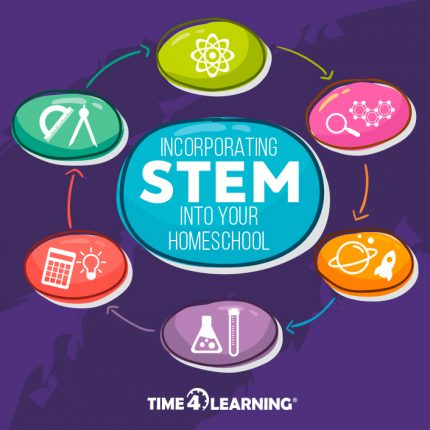
Incorporating STEM Into Your Homeschool
October 5, 2022This post is sponsored by Time4Learning.
Incorporating STEM (Science, Technology, Engineering, and Math) skills in your homeschool is becoming more and more important. It’s especially vital when it comes to future employment opportunities. Check out these stats about STEM jobs from the Bureau of Labor Statistics:
- Between 2017 and 2027, the number of STEM jobs will grow 13 percent, compared to 9 percent for non-STEM jobs.
- The average median hourly wage for STEM jobs is $38.85, compared to the median earnings for all other types of jobs in the US, which is $19.30.
- Out of 100 STEM occupations, 93% of them had wages above the national average.
Crazy, right? But then there was this alarming stat back in 2017—by the end of 2018, 2.4 million STEM jobs were projected to go unfilled as there are not enough qualified people. We, as homeschoolers, can change that by preparing our kids for challenging, fulfilling, and high-paying jobs. And it’s not hard, just think about all the everyday things that you and your children do that can build STEM skills, such as balancing your budget, using the computer, playing video games, visiting local science museums, attending robotic fairs, and more.
So, let’s start building our children’s STEM skills with these fun ideas!
STEM Subscription Boxes
These subscription boxes arrive once a month. How cool is that? It’s like a new and fun challenge every month with hands-on science experiments, online tutorials, videos, and more. The age groups run from three years old and up, which is nice because you can begin early and continue this educational experience as your kids get older.
There are many options, too, including the Amazon STEM club, Genius Box, Little Passports, STEM Discovery Boxes, and Spangler Science Club. Just do a quick Google search and you’ll find the ones that meet your criteria and age group.
Online Curriculum Courses
If your kids are like mine, then they love online games and courses. I use Time4Learning because it is broken down by grade level and my kids can retake lessons that they struggle with at any time. The multimedia lessons are like video games, which makes this system perfect for teaching new and more difficult math and science concepts. It also offers courses from pre-K through high school, so your kids will start learning and experiencing a STEM education at an early age.
There are other online resources as well, including Code.org, which teaches early elementary students coding with Minecraft, Elsa from Frozen, and Star Wars. The site also offers parental tutorials. Other websites I found are TeachEngineering.org and PBS’s Design Squad. Give them a whirl, they’re interesting and entertaining!
YouTube Video Projects
If you’re on a tight budget, these free videos are awesome. My son completed a “3D Solar System” project. It was fun and not expensive to purchase everything we needed. There’s also the ever-present “Volcano Eruption Project” and a really cool “Energy Transformation” video. These are not only educational, but they also provide quality family time that you can share with your children as they learn about new things.
Electronics Kits
My son’s grandfather was an electrician, so they naturally talk about all the things he’s done, such as wiring a house and fixing circuit breakers. They looked at technical diagrams together, and my son thought they looked like treasure maps! I know nothing about this stuff but when my son started showing an interest in electronics, I found EEME, (pronounced ee-me). They offer electronic kits that include all the parts necessary and an online video that walks your future electrician or engineer through the project. The first project is called “Genius Light.” The website says, “your kid will learn about LEDs, current, and resistors by building an LED circuit that lights up when it is dark and dims when it is bright.” As my kid said, “It sounds super cool!”
I must admit, I was a bit intimidated by STEM courses. I’m no scientist, engineer, computer code writer, or mathematician, but once I found all these cool tools, teaching/incorporating STEM courses was easy. I found the hardest part was getting my son to stop working on his projects and take a break!
Oh, I almost forgot, the other thing I noticed is how his reading improved. By carefully going over the directions on the kits, projects, and online lessons, he became more focused on understanding every last detail. So, if you haven’t yet, start incorporating STEM into your homeschool curriculum. Your child will be ready for a successful future in no time!
Additional Homeschool Resources
Teaching STEM in Your Homeschool
STEM Activities for Homeschoolers
6 Unique Ways to Include STEM in Your Homeschool Routine
Latest Posts

Guest Post by Gabriel Morse For several years, I sat for long hours every day behind one of those battleship gray desks in a windowless, dull, gray office. The pay was enough to take care…
Read more >
This post is sponsored by Little Monsters Universe. I'm Tina Salmanowitz, an advocate for homeschooling and science education. With over a decade of experience as a science educator (in class…
Read more >
This post is sponsored by Time4Learning. Before the pandemic, it was business as usual for Boca Raton resident Nikki Warris. Her two daughters, 5-year-old Natalie and 8-year-old Lexi were…
Read more >

